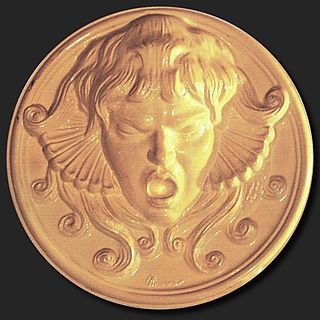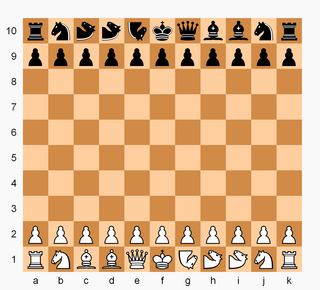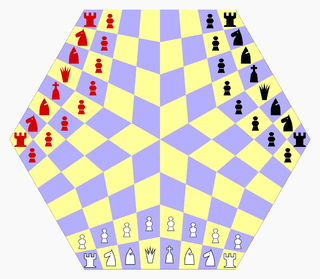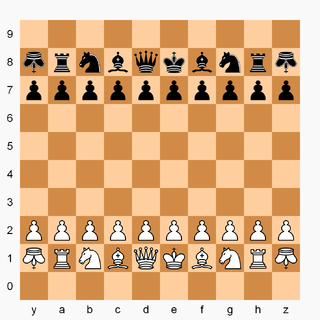Related Research Articles
Avalanche chess is a chess variant designed by Ralph Betza in 1977. After moving one of their own pieces, a player must move one of the opponent's pawns forward one square.
Circe chess is a chess variant in which captured pieces are reborn on their starting positions as soon as they are captured. The game was invented by French composer Pierre Monréal in 1967 and the rules of Circe chess were first detailed by Monréal and Jean-Pierre Boyer in an article in Problème, 1968.

Alice chess is a chess variant invented in 1953 by V. R. Parton which employs two chessboards rather than one, and a slight alteration to the standard rules of chess. The game is named after the main character "Alice" in Lewis Carroll's work Through the Looking-Glass, where transport through the mirror into an alternative world is portrayed on the chessboards by the after-move transfer of chess pieces between boards A and B.
A fairy chess piece, variant chess piece, unorthodox chess piece, or heterodox chess piece is a chess piece not used in conventional chess but incorporated into certain chess variants and some chess problems. Compared to conventional pieces, fairy pieces vary mostly in the way they move, but they may also follow special rules for capturing, promotions, etc. Because of the distributed and uncoordinated nature of unorthodox chess development, the same piece can have different names, and different pieces the same name in various contexts. Most are symbolised as inverted or rotated icons of the standard pieces in diagrams, and the meanings of these "wildcards" must be defined in each context separately. Pieces invented for use in chess variants rather than problems sometimes instead have special icons designed for them, but with some exceptions, many of these are not used beyond the individual games for which they were invented.

Vernon Rylands Parton was an English chess enthusiast and prolific chess variant inventor, his most renowned variants being Alice chess and Racing Kings. Many of Parton's variants were inspired by the fictional characters and stories in the works of Lewis Carroll. Parton's formal education background, like Lewis Carroll's, was in mathematics. Parton's interests were wide and he was a great believer in Esperanto.
Knight Relay chess is a chess variant invented by Mannis Charosh in 1972. In this game knights "relay" their power to friendly pieces.
Chess with different armies is a chess variant invented by Ralph Betza in 1979. Two sides use different sets of fairy pieces. There are several armies of equal strength to choose from, including the standard FIDE army. In all armies, kings and pawns are the same as in FIDE chess, but the four other pieces are different.

Cubic chess is a chess variant invented by Vladimír Pribylinec beginning with an early version in 1977. The game substitutes cubes for the chess pieces, where four of the faces of each cube display a different chess piece, the two other faces are blank and are orientated to the players. This provides an efficient means to change a piece's type. Kings and queens have unique cubes containing only their symbol, effectively behaving as normal.

2000 A.D. is a chess variant created by V. R. Parton which employs fairy chess pieces on a 10×10 board. Parton published the variant in his 1972 monograph My Game for 2000 A.D. and After.

Wildebeest chess is a chess variant created by R. Wayne Schmittberger in 1987. The Wildebeest board is 11×10 squares. Besides the standard chess pieces, each side has two camels and one "wildebeest" - a piece which may move as either a camel or a knight.

Dragonfly is a chess variant invented by Christian Freeling in 1983. There are no queens, and a captured bishop, knight, or rook becomes the property of the capturer, who may play it as his own on a turn to any open square. The board is 7×7 squares, or alternatively a 61-cell hexagon with two additional pawns per side.

Three-man chess is a chess variant for three players invented by George R. Dekle Sr. in 1984. The game is played on a hexagonal board comprising 96 quadrilateral cells. Each player controls a standard army of chess pieces.
The dabbaba, also known as the dabaaba or dabbabah, is a fairy chess piece that jumps two squares orthogonally, leaping over any intermediate piece. In algebraic notation, it is given the symbol D.

Stratomic is a chess variant invented by Robert Montay-Marsais in 1972. The game is played on a 10×10 board with all the standard chess pieces present, and in addition, two nuclea pieces and two extra pawns per side. The game brings the concept of modern warfare weaponry to chess.
Almost chess is a chess variant invented by Ralph Betza in 1977. The game is played using a standard chessboard and pieces, except that each player's queen is replaced by a chancellor, a piece which combines the moves of the rook and the knight.
Ralph Betza is a FIDE Master and inventor of chess variants such as Chess with different armies, Avalanche chess, and Way of the Knight.

Falcon–hunter chess is a chess variant invented by Karl Schultz in 1943, employing the two fairy chess pieces falcon and hunter. The game takes several forms, including variations hunter chess and decimal falcon–hunter chess added in the 1950s.

Hostage chess is a chess variant invented by John A. Leslie in 1997. Captured pieces are not eliminated from the game but can reenter active play through drops, similar to shogi. Unlike shogi, the piece a player may drop is one of their own pieces previously captured by the opponent. In exchange, the player returns a previously captured enemy piece which the opponent may drop on a future turn. This is the characteristic feature of the game.
Chess on a really big board is a large chess variant invented by Ralph Betza around 1996. It is played on a 16×16 chessboard with 16 pieces and 16 pawns per player. Since such a board can be constructed by pushing together four standard 8×8 boards, Betza also gave this variant the alternative names of four-board chess or chess on four boards.
References
- 1 2 Pritchard (1994), p. 210.
- ↑ Pritchard (1994), p. 213
- ↑ Pritchard (1994), p. 252
Bibliography
- Pritchard, D. B. (1994). The Encyclopedia of Chess Variants. Games & Puzzles Publications. ISBN 0-9524142-0-1.
- Pritchard, D. B. (2007). Beasley, John (ed.). The Classified Encyclopedia of Chess Variants. John Beasley. ISBN 978-0-9555168-0-1.